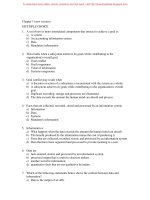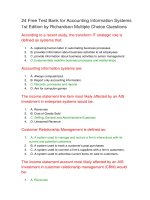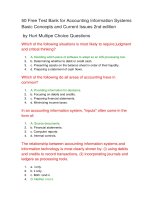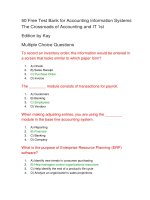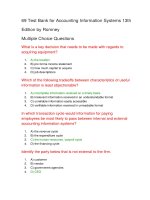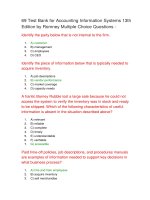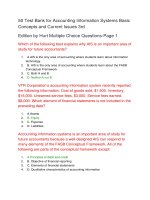95 test bank for fundamental accounting principles 21st edition
Bạn đang xem bản rút gọn của tài liệu. Xem và tải ngay bản đầy đủ của tài liệu tại đây (124.88 KB, 29 trang )
95 Test Bank for Fundamental Accounting Principles
21st Edition
by Wild Multiple Choice Questions
Revenue is properly recognized:
1.
A. When the customer's order is received.
2.
B. Only if the transaction creates an account receivable.
3.
C. At the end of the accounting period.
4.
5.
D. Upon completion of the sale or when services have been performed and
the business obtains the right to collect the sales price.
E. When cash from a sale is received.
On December 15 of the current year, Myers Legal Services signed
a $50,000 contract with a client to provide legal services to the
client in the following year. Which accounting principle would
require Myers Legal Services to record the legal fees revenue in the
following year and not the year the cash was received?
1.
A. Monetary unit assumption.
2.
B. Going-concern assumption.
3.
C. Cost principle.
4.
D. Business entity assumption.
5.
E. Revenue recognition principle.
The accounting assumption that requires every business to be
accounted for separately from other business entities, including its
owner or owners is known as the:
1.
A. Time-period assumption.
2.
B. Business entity assumption.
3.
C. Going-concern assumption.
4.
D. Revenue recognition principle.
5.
E. Cost principle.
Social responsibility:
1.
A. Is a concern for the impact of our actions on society.
2.
B. Is a code that helps in dealing with confidential information.
3.
C. Is required by the SEC.
4.
D. Requires that all businesses conduct social audits.
5.
E. Is limited to large companies.
The accounting concept that requires financial statement
information to be supported by independent, unbiased evidence
other than someone's belief or opinion is:
1.
A. Business entity assumption.
2.
B. Monetary unit assumption.
3.
C. Going-concern assumption.
4.
D. Time-period assumption.
5.
E. Objectivity
A partnership:
1.
A. Is also called a sole proprietorship.
2.
B. Has unlimited liability for its partners.
3.
C. Has to have a written agreement in order to be legal.
4.
D. Is a legal organization separate from its owners.
5.
E. Has owners called shareholders.
Marian Mosely is the owner of Mosely Accounting Services. Which
accounting principle requires Marian to keep her personal financial
information separate from the financial information of Mosely
Accounting Services?
1.
A. Monetary unit assumption.
2.
B. Going-concern assumption.
3.
C. Cost principle.
4.
D. Business entity assumption.
5.
E. Matching principle.
The Maxim Company acquired a building for $500,000. Maxim had
the building appraised, and found that the building was easily worth
$575,000. The seller had paid $300,000 for the building 6 years
ago. Which accounting principle would require Maxim to record the
building on its records at $500,000?
1.
A. Monetary unit assumption.
2.
B. Going-concern assumption.
3.
C. Cost principle.
4.
D. Business entity assumption.
5.
E. Revenue recognition principle.
External users of accounting information include all of the following
except:
1.
A. Shareholders.
2.
B. Customers.
3.
C. Purchasing managers.
4.
D. Government regulators.
5.
E. Creditors.
A corporation:
1.
A. Is a business legally separate from its owners.
2.
3.
B. Is controlled by the FASB.
C. Has shareholders who have unlimited liability for the acts of the
corporation.
4.
D. Is the same as a limited liability partnership.
5.
E. Is not subject to double taxation.
All of the following regarding a Certified Public Accountant are true
except:
1.
A. Must meet education and experience requirements.
2.
B. Must pass an examination.
3.
C. Must exhibit ethical character.
4.
D. May also be a Certified Management Accountant.
5.
E. Cannot hold any certificate other than a CPA.
The private group that currently has the authority to establish
generally accepted accounting principles in the United States is
the:
1.
A. APB.
2.
B. FASB.
3.
C. AAA.
4.
D. AICPA.
5.
E. SEC.
To include the personal assets and transactions of a business's
owner in the records and reports of the business would be in
conflict with the:
1.
A. Objectivity principle.
2.
B. Monetary unit assumption.
3.
C. Business entity assumption.
4.
D. Going-concern assumption.
5.
E. Revenue recognition principle.
The rule that (1) requires revenue to be recognized at the time it is
earned, (2) allows the inflow of assets associated with revenue to
be in a form other than cash, and (3) measures the amount of
revenue as the cash plus the cash equivalent value of any noncash
assets received from customers in exchange for goods or services,
is called the:
1.
A. Going-concern assumption.
2.
B. Cost principle.
3.
C. Revenue recognition principle.
4.
D. Objectivity principle.
5.
E. Business entity assumption.
Ethical behavior requires:
1.
A. That auditors' pay not depend on the success of the client's business.
2.
B. Auditors to invest in businesses they audit.
3.
C. Analysts to report information favorable to their companies.
4.
D. Managers to use accounting information to benefit themselves.
5.
E. That auditors' pay depend on the success of the client's business.
An example of a financing activity is:
1.
A. Buying office supplies.
2.
B. Obtaining a long-term loan.
3.
C. Buying office equipment.
4.
D. Selling inventory.
5.
E. Buying land.
All of the following are true regarding ethics except:
1.
A. Ethics are beliefs that separate right from wrong.
2.
B. Ethics rules are often set for CPAs.
3.
C. Ethics do not affect the operations or outcome of a company.
4.
D. Are critical in accounting.
5.
E. Ethics can be hard to apply.
The accounting principle that requires accounting information to be
based on actual cost and requires assets and services to be
recorded initially at the cash or cash-equivalent amount given in
exchange, is the:
1.
A. Accounting equation.
2.
B. Cost principle.
3.
C. Going-concern assumption.
4.
D. Realization principle.
5.
E. Business entity assumption.
If a parcel of land that was originally purchased for $85,000 is
offered for sale at $150,000, is assessed for tax purposes at
$95,000, is recognized by its purchasers as easily being worth
$140,000, and is sold for $137,000, the land account transaction
amount to handle the sale of the land in the seller's books is:
1.
A. $85,000 increase.
2.
B. $85,000 decrease.
3.
C. $137,000 increase.
4.
D. $137,000 decrease.
5.
E. $140,000 decrease.
The rule that requires financial statements to reflect the assumption
that the business will continue operating instead of being closed or
sold, unless evidence shows that it will not continue, is the:
1.
A. Going-concern assumption.
2.
B. Business entity assumption.
3.
C. Objectivity principle.
4.
D. Cost Principle.
5.
E. Monetary unit assumption.
If a parcel of land that was originally acquired for $85,000 is offered
for sale at $150,000, is assessed for tax purposes at $95,000, is
recognized by its purchasers as easily being worth $140,000, and is
sold for $137,000, the land should be recorded in the purchaser's
books at:
1.
A. $95,000.
2.
B. $137,000.
3.
C. $138,500.
4.
D. $140,000.
5.
E. $150,000.
If a parcel of land that was originally purchased for $85,000 is
offered for sale at $150,000, is assessed for tax purposes at
$95,000, is recognized by its purchasers as easily being worth
$140,000, and is sold for $137,000. What is the effect of the sale on
the accounting equation for the seller?
1.
A. Assets increase $52,000; owner's equity increases $52,000.
2.
B. Assets increase $85,000; owner's equity increases $85,000.
3.
C. Assets increase $137,000; owner's equity increases $137,000.
4.
D. Assets increase $140,000; owner's equity increases $140,000.
5.
E. Assets decrease $85,000; owner's equity decreases $85,000.
If a parcel of land that was originally purchased for $85,000 is
offered for sale at $150,000, is assessed for tax purposes at
$95,000, is recognized by its purchasers as easily being worth
$140,000, and is sold for $137,000. At the time of the sale, assume
that the seller still owed $30,000 to TrustOne Bank on the land that
was purchased for $85,000. Immediately after the sale, the seller
paid off the loan to TrustOne Bank. What is the effect of the sale
and the payoff of the loan on the accounting equatio
1.
A. Assets increase $52,000; owner's equity increases $22,000; liabilities
decrease $30,000
2.
B. Assets increase $52,000; owner's equity increases $30,000; liabilities
decrease $30,000
3.
C. Assets increase $22,000; owner's equity increases $52,000; liabilities
decrease $30,000
4.
D. Assets decrease $30,000; owner's equity decreases $30,000; liabilities
decrease $30,000
5.
E. Assets decrease $55,000; owner's equity decreases $55,000; liabilities
decrease $30,000
Accounting is an information and measurement system that does all
of the following except:
1.
A. Identifies business activities.
2.
B. Records business activities.
3.
C. Communicates business activities.
4.
D. Does not use technology to improve accuracy in reporting.
5.
E. Helps people make better decisions.
The area of accounting aimed at serving the decision making needs
of internal users is:
1.
A. Financial accounting.
2.
B. Managerial accounting.
3.
C. External auditing.
4.
D. SEC reporting.
5.
E. Bookkeeping.
Which of the following accounting principles prescribes that a
company record its expenses incurred to generate the revenue
reported?
1.
A. Going-concern assumption.
2.
B. Matching principle.
3.
C. Cost principle.
4.
D. Business entity assumption.
5.
E. Consideration assumption.
The International Accounting Standards Board (IASB):
1.
A. Hopes to create harmony among accounting practices of different
countries.
2.
B. Is the government group that establishes reporting requirements for
companies that issue stock to the public.
3.
C. Has the authority to impose its standards on companies.
4.
D. Is the only source of generally accepted accounting principles (GAAP).
5.
E. Only applies to companies that are members of the European Union.
The group that attempts to create more harmony among the
accounting practices of different countries is the:
1.
A. AICPA.
2.
B. IASB.
3.
C. CAP.
4.
D. SEC.
5.
E. FASB.
Technology:
1.
A. Has replaced accounting.
2.
B. Has not changed the work that accountants do.
3.
C. Has closely linked accounting with consulting, planning, and other financial
services.
4.
D. In accounting has replaced the need for decision makers.
5.
E. In accounting is only available to large corporations.
A limited partnership:
1.
A. Includes a general partner with unlimited liability.
2.
B. Is subject to double taxation.
3.
C. Has owners called stockholders.
4.
D. Is the same as a corporation.
5.
E. May only have two partners.
The primary objective of financial accounting is:
1.
2.
3.
4.
5.
A. To serve the decision-making needs of internal users.
B. To provide financial statements to help external users analyze an
organization's activities.
C. To monitor and control company activities.
D. To provide information on both the costs and benefits of looking after
products and services.
E. To know what, when, and how much to produce.
The question of when revenue should be recognized on the income
statement (according to GAAP) is addressed by the:
1.
A. Revenue recognition principle.
2.
B. Going-concern assumption.
3.
C. Objectivity principle.
4.
D. Business entity assumption.
5.
E. Cost principle.
Which of the following accounting principles would require that all
goods and services purchased be recorded at cost?
1.
A. Going-concern assumption.
2.
B. Matching principle.
3.
C. Cost principle.
4.
D. Business entity assumption.
5.
E. Consideration assumption.
95 Free Test Bank for Fundamental Accounting
Principles 21st Edition by Wild Multiple Choice
Questions - Part 2
Revenues are:
1.
A. The same as net income.
2.
B. The excess of expenses over assets.
3.
C. Resources owned or controlled by a company
4.
D. The increase in equity from a company’s earning activities.
5.
E. The costs of assets or services used.
A payment to an owner is called a(n):
1.
A. Liability.
2.
B. Withdrawal.
3.
C. Expense.
4.
D. Contribution.
5.
E. Investment.
If assets are $365,000 and equity is $120,000, then liabilities are:
1.
A. $120,000.
2.
B. $245,000.
3.
C. $365,000.
4.
D. $485,000.
5.
E. $610,000.
The assets of a company total $700,000; the liabilities, $200,000.
What are the claims of the owners?
1.
A. $900,000.
2.
B. $700,000.
3.
C. $500,000.
4.
D. $200,000.
5.
E. It is impossible to determine unless the amount of this owners' investment
is known.
Net Income:
1.
A. Decreases equity.
2.
B. Represents the amount of assets owners put into a business.
3.
C. Equals assets minus liabilities.
4.
D. Is the excess of revenues over expenses.
5.
E. Represents owners' claims against assets.
Distributions of assets by a business to its owners are called:
1.
A. Withdrawals.
2.
B. Expenses.
3.
C. Assets.
4.
D. Retained earnings.
5.
E. Net Income.
Viscount Company collected $42,000 cash on its accounts
receivable. The effects of this transaction as reflected in the
accounting equation are:
1.
A. Total assets decrease and equity increases.
2.
B. Both total assets and total liabilities decrease.
3.
C. Total assets, total liabilities, and equity are unchanged.
4.
D. Both total assets and equity are unchanged and liabilities increase.
5.
E. Total assets increase and equity decreases.
Zion Company has assets of $600,000, liabilities of $250,000, and
equity of $350,000. It buys office equipment on credit for $75,000.
What would be the effects of this transaction on the accounting
equation?
1.
A. Assets increase by $75,000 and expenses increase by $75,000.
2.
B. Assets increase by $75,000 and expenses decrease by $75,000.
3.
C. Liabilities increase by $75,000 and expenses decrease by $75,000.
4.
D. Assets decrease by $75,000 and expenses decrease by $75,000.
5.
E. Assets increase by $75,000 and liabilities increase by $75,000.
If assets are $99,000 and liabilities are $32,000, then equity
equals:
1.
A. $32,000.
2.
B. $67,000.
3.
C. $99,000.
4.
D. $131,000.
5.
E. $198,000.
How would the accounting equation of Boston Company be affected
by the billing of a client for $10,000 of consulting work completed?
1.
A. +$10,000 accounts receivable, -$10,000 accounts payable.
2.
B. +$10,000 accounts receivable, +$10,000 accounts payable.
3.
C. +$10,000 accounts receivable, +$10,000 cash.
4.
D. +$10,000 accounts receivable, +$10,000 revenue.
5.
E. +$10,000 accounts receivable, -$10,000 revenue.
If a company paid $38,000 of its accounts payable in cash, what
was the effect on the assets, liabilities, and equity?
1.
A. Assets would decrease $38,000, liabilities would decrease $38,000, and
equity would decrease $38,000.
2.
B. Assets would decrease $38,000, liabilities would decrease $38,000, and
equity would increase $38,000.
3.
C. Assets would decrease $38,000, liabilities would decrease $38,000, and
equity would not change.
4.
D. There would be no effect on the accounts because the accounts are
affected by the same amount.
5.
E. None of these.
An example of an operating activity is:
1.
A. Paying wages.
2.
B. Purchasing office equipment.
3.
C. Borrowing money from a bank.
4.
D. Selling stock.
5.
E. Paying off a loan.
If the liabilities of a business increased $75,000 during a period of
time and the owner's equity in the business decreased $30,000
during the same period, the assets of the business must have:
1.
A. Decreased $105,000.
2.
B. Decreased $45,000.
3.
C. Increased $30,000.
4.
D. Increased $45,000.
5.
E. Increased $105,000.
Resources that are expected to yield future benefits are:
1.
A. Assets.
2.
B. Revenues.
3.
C. Liabilities.
4.
D. Owner's Equity.
5.
E. Expenses.
Reston had income of $150 million and average invested assets of
$1,800 million. Its return on assets is:
1.
A. 8.3%.
2.
B. 83.3%.
3.
C. 12%.
4.
D. 120%.
5.
E. 16.7%.
If equity is $300,000 and liabilities are $192,000, then assets equal:
1.
A. $108,000.
2.
B. $192,000.
3.
C. $300,000.
4.
D. $492,000.
5.
E. $792,000.
Another name for equity is:
1.
A. Net income.
2.
B. Expenses.
3.
C. Net assets.
4.
D. Revenue.
5.
E. Net loss.
The difference between a company's assets and its liabilities, or net
assets is:
1.
A. Net income.
2.
B. Expense.
3.
C. Equity.
4.
D. Revenue.
5.
E. Net loss.
If the assets of a business increased $89,000 during a period of
time and its liabilities increased $67,000 during the same period,
equity in the business must have:
1.
A. Increased $22,000.
2.
B. Decreased $22,000.
3.
C. Increased $89,000.
4.
D. Decreased $156,000.
5.
E. Increased $156,000.
An example of an investing activity is:
1.
A. Paying wages of employees.
2.
B. Withdrawals by the owner.
3.
C. Purchase of land.
4.
D. Selling inventory.
5.
E. Contribution from owner.
Operating activities:
1.
A. Are the means organizations use to pay for resources like land, buildings
and equipment.
2.
B. Involve using resources to research, develop, purchase, produce, distribute
and market products and services.
3.
C. Involve acquiring and disposing of resources that a business uses to
acquire and sell its products or services.
4.
D. Are also called asset management.
5.
E. Are also called strategic management.
Creditors' claims on the assets of a company are called:
1.
A. Net losses.
2.
B. Expenses.
3.
C. Revenues.
4.
D. Equity.
5.
E. Liabilities.
Photometer Company paid off $30,000 of its accounts payable in
cash. What would be the effects of this transaction on the
accounting equation?
1.
A. Assets, $30,000 increase; liabilities, no effect; equity, $30,000 increase.
2.
B. Assets, $30,000 decrease; liabilities, $30,000 decrease; equity, no effect.
3.
C. Assets, $30,000 decrease; liabilities, $30,000 increase; equity, no effect.
4.
D. Assets, no effect; liabilities, $30,000 decrease; equity, $30,000 increase.
5.
E. Assets, $30,000 decrease; liabilities, no effect; equity $30,000 decrease.
Decreases in equity that represent costs of assets or services used
to earn revenues are called:
1.
A. Liabilities.
2.
B. Equity.
3.
C. Withdrawals.
4.
D. Expenses.
5.
E. Owner's Investment.
Increases in equity from a company's earnings activities are:
1.
A. Assets.
2.
B. Revenues.
3.
C. Liabilities.
4.
D. Owner's Equity.
5.
E. Expenses.
On June 30 of the current year, the assets and liabilities of Phoenix,
Inc. are as follows: Cash $20,500; Accounts Receivable, $7,250;
Supplies, $650; Equipment, $12,000; Accounts Payable, $9,300.
What is the amount of owner's equity as of June 30 of the current
year?
1.
A. $8,300
2.
B. $13,050
3.
C. $20,500
4.
D. $31,100
5.
E. $40,400
If the liabilities of a company increased $74,000 during a period of
time and equity in the company decreased $19,000 during the
same period, what was the effect on the assets?
1.
A. Assets would have increased $55,000.
2.
B. Assets would have decreased $55,000.
3.
C. Assets would have increased $19,000.
4.
D. Assets would have decreased $19,000.
5.
E. None of these.
Assets created by selling goods and services on credit are:
1.
A. Accounts payable.
2.
B. Accounts receivable.
3.
C. Liabilities.
4.
D. Expenses.
5.
E. Equity.
An exchange of value between two entities is called:
1.
A. The accounting equation.
2.
B. Recordkeeping or bookkeeping.
3.
C. An external transaction.
4.
D. An asset.
5.
E. Net Income.
The description of the relation between a company's assets,
liabilities, and equity, which is expressed as Assets = Liabilities +
Equity, is known as the:
1.
A. Income statement equation.
2.
B. Accounting equation.
3.
C. Business equation.
4.
D. Return on equity ratio.
5.
E. Net income.
The excess of expenses over revenues for a period is:
1.
A. Net assets.
2.
B. Equity.
3.
C. Net loss.
4.
D. Net income.
5.
E. A liability.
95 Free Test Bank for Fundamental Accounting
Principles 21st Edition by Wild Multiple Choice
Questions - Part 3
Della's Donuts owner made investments of $50,000 and
withdrawals of $20,000. The company has revenues of $83,000 and
expenses of $64,000. Calculate its net income.
1.
A. $30,000.
2.
B. $83,000.
3.
C. $64,000.
4.
D. $19,000.
5.
E. $49,000.
U. S. government bonds are:
1.
A. High-risk and high-return investments.
2.
B. Low-risk and low-return investments.
3.
C. High-risk and low-return investments.
4.
D. Low-risk and high-return investments.
5.
E. High risk and no-return investments.
The statement of cash flows reports all of the following except:
1.
A. Cash flows from operating activities.
2.
B. Cash flows from investing activities.
3.
C. Cash flows from financing activities.
4.
D. The net increase or decrease in assets for the period reported.
5.
E. The net increase or decrease in cash for the period reported.
Flash reported net income of $17,500 for the past year. At the
beginning of the year the company had $200,000 in assets and
$50,000 in liabilities. By the end of the year, assets had increased
to $300,000 and liabilities were $75,000. Calculate its return on
assets:
1.
A. 8.8%
2.
B. 7.0%
3.
C. 5.8%
4.
D. 35.0%
5.
E. 23.3%
Nick’s had income of $350 million and average invested assets of
$2,000 million. Its ROA is:
1.
A. 1.8%.
2.
B. 35%.
3.
C. 17.5%.
4.
D. 5.7%.
5.
E. 3.5%.
Harris Co. has a net income of $43,000, assets at the beginning of
the year are $250,000 and assets at the end of the year are
$300,000. Compute its return on assets.
1.
A. 8.4%
2.
B. 17.2%
3.
C. 14.3%
4.
D. 15.6%
5.
E. 1.5%
Determine the net income of a company for which the following
information is available for the month of May. Employee salaries
expense: $180,000; Interest expense: 10,000; Rent expense:
20,000; Consulting revenue: 400,000
1.
A. $190,000.
2.
B. $210,000.
3.
C. $230,000.
4.
D. $400,000.
5.
E. $610,000.
Quick Computer Service had revenues of $80,000 and expenses of
$50,000 for the year. Its assets at the beginning of the year were
$400,000. At the end of the year assets were worth $450,000.
Calculate its return on assets.
1.
A. 7.1%
2.
B. 7.5%
3.
C. 6.7%
4.
D. 20.0%
5.
E. 18.8%
A company acquires equipment for $75,000 cash. This represents
a(n):
1.
A. Operating activity.
2.
B. Investing activity.
3.
C. Financing activity.
4.
D. Revenue activity.
5.
E. Expense activity.
Use the following information as of December 31 to determine
equity: Liabilities of $141,000; Cash of 57,000 Equipment of
206,000; Buildings of 175,000
1.
A. $57,000.
2.
B. $141,000.
3.
C. $297,000.
4.
D. $438,000.
5.
E. $579,000.
Cash investments by owners are listed on which of the following
statements?
1.
A. Balance sheet.
2.
B. Income statement.
3.
C. Statement of owner's equity only.
4.
D. Statement of cash flows only.
5.
E. Statement of owner's equity and statement of cash flows.
Flash had cash inflows from operations $62,500; cash outflows
from investing activities of $47,000; and cash inflows from financing
of $25,000. The net change in cash was:
1.
A. $40,500 increase.
2.
B. $40,500 decrease.
3.
C. $134,500 decrease.
4.
D. $134,000 increase.
5.
E. $9,500 increase.
A company's balance sheet shows: cash $24,000, accounts
receivable $30,000, equipment $50,000, and equity $72,000. What
is the amount of liabilities?
1.
A. $104,000.
2.
B. $76,000.
3.
C. $32,000.
4.
D. $68,000.
5.
E. $176,000.
The income statement reports all of the following except:
1.
A. Revenues earned by a business.
2.
B. Expenses incurred by a business.
3.
C. Assets owned by a business.
4.
D. Net income or loss earned by a business.
5.
E. The time period over which the earnings occurred.
The financial statement that identifies where a company's cash
came from and where it went during the period is the:
1.
A. Statement of financial position.
2.
B. Statement of cash flows.
3.
C. Balance sheet.
4.
D. Income statement.
5.
E. Statement of changes in owner's equity.
The basic financial statements include all of the following except:
1.
A. Balance Sheet.
2.
B. Income Statement.
3.
C. Statement of Owner's Equity.
4.
D. Statement of Cash Flows.
5.
E. Trial Balance.
A financial statement providing information that helps users
understand a company's financial status, and which lists the types
and amounts of assets, liabilities, and equity as of a specific date, is
called a(n):
1.
A. Balance sheet.
2.
B. Income statement.
3.
C. Statement of cash flows.
4.
D. Statement of owner's equity.
5.
E. Financial Status Statement.
The financial statement that shows the beginning balance of
owner's equity; the changes in equity that resulted from new
investments by the owner, net income (or net loss); withdrawals;
and the ending balance, is the:
1.
A. Statement of financial position.
2.
B. Statement of cash flows.
3.
C. Balance sheet.
4.
D. Income statement.
5.
E. Statement of owner's equity.
